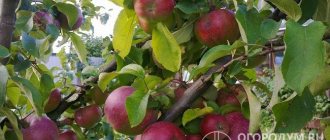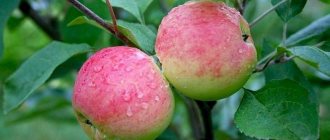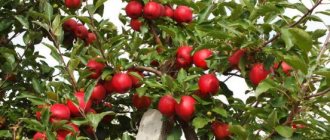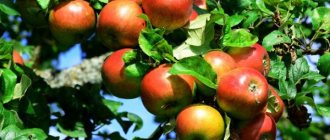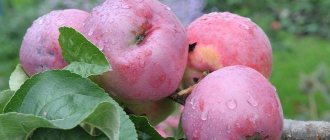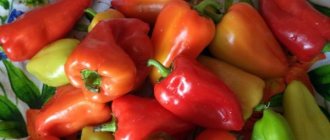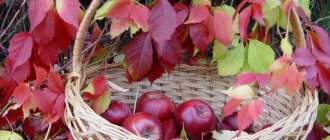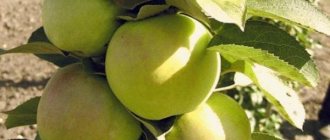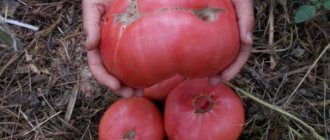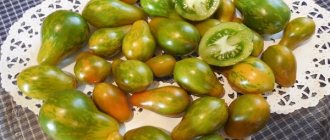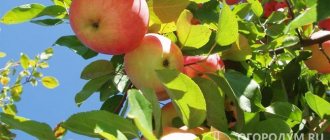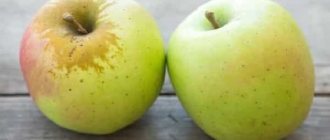Sometimes there are apple trees with beautiful fruits, but the taste of the apples is completely inexpressive. This type only causes disappointment and slight annoyance. In order not to experience such feelings, you should pay attention to the Red Free variety, which combines not only the attractiveness of the fruit and wonderful taste, but also many other positive qualities.
Fruit of the Red Free apple tree.
Description of the variety
One of the first varieties, immune to five races of scab, was the Red Free variety, obtained in the USA as a result of crossing the abundantly flowering apple tree (M. floribunda Sieb. 821) with a domestic (cultivated) apple tree. The summer ripening variety showed itself well in the conditions of central Russia. Biological description of the apple tree:
- medium-sized tree with a round, unthickened crown of irregular shape;
- skeletal branches grow almost at right angles to the trunk;
- leaves are medium-sized, dark green, glossy;
- white inflorescences;
- The fruits are round, medium and large in size with a bright crimson blush.
The photo shows Red Free apples.
Video Review
There are many types of apple trees designed for growing in temperate continental climates. Most of them are able to withstand the vagaries of weather, resist parasites and produce a bountiful harvest of delicious fruits. But you just can’t compare with the Red Free apple tree, which enjoys the well-deserved love of gardeners in Russia, Europe and the USA. And such popularity is well deserved! The tree is easy to care for, attractive in appearance, and Redfree apples are not only tasty, but also very healthy.
Characteristic
Like any representative of apple crops, the Red Free apple tree has its own characteristics.
Advantages and disadvantages
Red Free has many advantages among summer apple trees:
- genetic immunity to scab;
- high marketability of fruits;
- excellent taste;
- good transportability;
- precociousness;
- regular fruiting;
- good frost resistance.
The disadvantages of the variety include:
- instability to powdery mildew;
- poor pollen viability;
- fruit shrinkage due to overload.
Dimensions of an adult tree
The apple tree is a medium-sized variety; the height of an adult tree does not exceed four meters. The crown is not dense and has an irregular round shape. Despite its roundness, the crown is spreading.
Mature apple tree.
Annual growth
The variety is considered fast-growing: by the age of seven years the tree reaches its maximum growth.
Frequency of fruiting
No periodicity in fruiting was noticed: Red Free pleases with stable harvests without rest periods.
Productivity
An adult tree produces about 50 kg of apples per season. The apple tree begins to bear fruit at the age of 3-4 years, with a subsequent increase in the number of fruits. In maturity, the apple tree reaches its maximum yield.
Tasting assessment
Apples have a caramel aroma, the taste of the pulp is sweet and sour, dessert. The pulp is very juicy. Taste score 4.7 out of 5.
Winter hardiness
Red Free belongs to the group of medium-winter-hardy varieties. It is able to withstand winter temperatures down to -35.
Apple tree in winter.
At the same time, spring return frosts can cause irreparable damage to the apple tree, since the variety is characterized by early flowering.
Disease resistance
Red Free is a carrier of the Vf gene and is immune to leaf and fruit scab. American breeders deliberately worked to develop a variety that is resistant to this disease. However, Red Free does not have the same resistance to powdery mildew.
Apple tree Red Free
Apple trees were planted 5 years ago on a summer cottage.
Now they have grown to 4 meters in height. The crown is spreading; when planting, they specially left 4 meters between the trees. There are few branches on the tree, the crown is round in shape. Almost every year, apple trees produce a good harvest, ripen together, and we collect everything in one go. From the 4th year we collect at least 50 kilograms from the apple tree. The taste of apples is sweet and sour, with a wonderful caramel aroma. The pulp is fine-grained. Apples are unusually juicy and produce good juice. For powdery mildew, it is necessary to treat with fungicides in early spring, before the buds open. In spring and summer, we regularly water - 3-4 buckets of water once a week and then mulch the circle around the trunk - this way the apples are guaranteed not to fall off in hot weather. This variety is usually ready for consumption in early August. You can start eating them right away. The apple trees began to bear fruit in the 2nd year, but we collect a full harvest from the 4th year after planting the seedlings. The apples are very attractive in appearance - green-yellow, with a bright red color throughout the apple. The skin of the apple is dense, resistant to squeezing and other damage. Due to this, apples are suitable for long-term transportation and are stored quite well at cool temperatures. The pulp is juicy, aromatic, rather sweet than sour, not very hard - eating such an apple fresh is a particular pleasure. This variety of apples has a high content of vitamin C and microelements.
Red fries are a very effective variety in terms of return on investment. The costs of planting and care pay off quite quickly. The apple tree is early-bearing, so you won’t have to wait long for the harvest. At 5-6 years it reaches its maximum maturity. It begins to bear fruit at 3 years of age. The first harvest was very small, about 30 kg of apples per tree. Over time, the apple tree gained strength and the harvest began to reach 40-50 kg per tree. The fruits are sweet, with only slight sourness. The peel is smooth, sweet, thin and shiny. The color of the fruits ranges from bright red to burgundy-brown. Harvesting occurs at the end of summer. The first apples ripen in August. The fruits are not stored for long, a maximum of 2 months. Almost everything is spent on food, they are very tasty and it’s simply a pity to use them for winter preparations. The downside of the variety is its susceptibility to powdery mildew, while scab almost does not cling to it.
The Red Free variety combines an expressive apple taste and attractive appearance. The apple tree is a summer variety. The homeland is America. The variety was obtained through selection. The taste of apples is dessert, sweet and sour, pleasant. The color is yellow-green with a striped red blush. The blush occupies most of the apple, so the fruit looks bright and impressive. The pulp is juicy and tender. It is believed that apples of this variety are rich in vitamins and microelements. The tree begins to bear fruit quickly and does not require special care. The variety is resistant to diseases. The only negative that is worth mentioning is the low resistance to powdery mildew. The tree does not grow tall, which makes it easy to care for. The apple tree bears fruit annually. For a good harvest, you must not forget about pruning. The maximum yield begins to be produced by the age of 8. Approximately a tree produces 50 kg of apples. It all depends on care, soil, climatic conditions. It is better to plant in a temperate and warm climate, since the tree may not tolerate low frosts in winter.
Planting and care
The Red Free apple tree variety is unpretentious, so it does not impose any special requirements for planting and care.
Timing and scheme
Planting dates are generally accepted, suitable for any apple trees grown in a particular region. The planting pattern is as follows: the distance between trees is 2.5 meters, between rows - 4 meters.
Agricultural technology and cultivation
For proper cultivation, you only need to comply with the standard requirements required for the cultivation of apple crops:
- choosing the right place for planting: non-acidified soil, sunny place, no drafts;
- groundwater occurrence at a depth of 2.5 meters;
- preparing a planting hole 60 cm deep and 100 cm in diameter a month before the planned planting of the seedling;
- if planting is carried out in the spring, the seedling requires regular watering;
- mineral fertilizers and organic matter begin to be applied to the tree trunk in the second or third year after planting;
- preventive treatment with fungicides and insecticides;
- To avoid chopping apples, it is necessary to standardize flowers or ovaries. This procedure is carried out only once, then the apple tree itself begins to regulate the formation of fruit ovaries.
Apple tree planting scheme.
Pruning and crown formation
Red Free's crown is not thickened, so it practically does not need formative pruning. It is only necessary to monitor and prevent the growth of branches into the crown. The apple tree tolerates anti-aging pruning well.
Pollinator varieties
The viability of Red Free's pollen is weak, so it is necessary to plant an apple tree with a similar flowering period nearby and attract pollinating insects to the area.
Methods of controlling diseases and pests
To protect the plant from pests and diseases, it is necessary to carry out regular preventive treatments with chemicals.
Red Free is resistant to typical apple tree diseases, but it can still become infected with the following:
- Scab . Appears as olive spots at the bottom of the plant. To prevent their occurrence, it is recommended to treat it with fungicides containing sulfur or lime. If the problem has already arisen, it can be eliminated by treating the tree trunk circle with a solution of 10% ammonium nitrate.
- Bacterial burn . Characterized by the appearance of brown spots. For prevention, fertilizer should be applied in early spring. To eliminate an existing burn, it is recommended to dilute 1 ampoule of Ampicillin in a bucket of water and spray the resulting liquid onto the tree at each stage of the growing season. In addition, you can use other drugs, such as Fitolavin, Tetracycline, Streptomycin, Ofloxacin, Gentamicin.
- Powdery mildew . First, a white cobweb appears on the back of the leaves, then this leads to their drying out. At the same time, small black dots begin to spread on the fruits. To avoid this, it is recommended to plant trees at a sufficient distance from each other. To combat this problem, it is recommended to spray with a fungicide solution: 3–5 times throughout the summer (once every 12–15 days).
The apple tree is also susceptible to attack by the following insects:
- Apple moth. A 6 mm long fly infects fruits by digging into the fruit, forming passages in it and violating the integrity of the shell. For active control of insects, it is recommended to use drugs such as “Atom”, “Ditox”, “Dimetoat”, “Rogor-S”, “Tod”, “Fufanon”, “Zolon”, “Sirocco”, “Pirinex”, “ Fosban" and others.
- Apple flower beetle. The beetle eats tree buds, laying up to 100 eggs in them. The larvae grow and begin to eat the structural elements of the flower (pistil and stamens), as a result of which the buds never open. To eliminate the insect, it is recommended to attach a bunch of hay soaked in karbofos to the top of the trunk.
- Apple sucker. The 2.5 mm long insect sucks sap from the tree through the leaves, which causes the apple tree to wilt. It is recommended to treat the tree with Decis before flowering, diluting 1 ampoule (2 ml) in 10 liters of water.
Features of ripening and fruiting
The variety belongs to the early-fruiting and productive varieties.
Beginning of fruiting
The apple tree begins to bear fruit quite early. Already at the age of three, the first apples may appear on the tree. With age, the number of fruits increases, and at the age of seven years the apple tree begins to produce full, abundant harvests.
Peculiarities
The type of fruiting is mixed: fruit ovaries are formed on spears, fruit twigs and ringlets.
Deadlines
A variety with mid-summer fruit ripening period.
Bloom
Flowering occurs early, in May, and lasts about ten days. Friendly, but not very plentiful.
Apple tree blossom.
Fruit ripening
The apples ripen at the same time, around mid-August. Ripe fruits do not fall off.
Storage and harvesting
Apples reach consumer maturity at the same time they are harvested. The fruits can be stored in a cool, well-ventilated place for up to two months. At the same time, they fully retain their consumer qualities.
Advantages and disadvantages
By crossing different types of apple trees, scientists have a single goal - to obtain a variety that is superior to the parent samples in all respects. In the case of the Red Free apple tree, they managed to achieve what they wanted. Although some properties of the plant were not ideal.
Advantages of the Redfrey variety
- Sweet, slightly caramel and definitely memorable taste of the fruit.
- Recognized commercial qualities that apples owe to their strong, smooth skin.
- Immunity to most parasites, including scab.
- High yield and regularity of fruiting.
Flaws
- The tree does not have stable immunity to powdery mildew.
- Apple flower pollen has low viability. Without artificial pollination, fruits are formed only in 15% of cases.
Best Growing Regions
Red Free is not included in the State Register, but is grown by enthusiastic gardeners in the Moscow, Leningrad, Tver, Novgorod, Saratov regions, Tatarstan, the Southern Urals and even Karelia. Experts recommend this variety for cultivation in the Central region.
Growing apple trees in the Central region.
Cultivation is allowed in the Volga-Vyatka and Middle Volga regions. The variety also does well in the southern regions of the country.
Reviews
Mikhail, Samara region: “I planted the first apple trees at the dacha about eight years ago. Now these are already mature trees, which delight us with good harvests every summer. Apples are very tasty, very juicy and aromatic. You can eat it straight from the tree. My wife now says that Red Free is her favorite variety, because apples make wonderful preparations for the winter. The children are literally squealing with delight: they really like eating fresh apples.”
Svetlana, Kirov region: “I am a beginner gardener. One day, neighbors treated us to beautiful and incredibly tasty apples. When I asked about the variety, they answered that it was Red Free. At first I decided that during the season I would just buy apples from them, fortunately they always have a surplus. And then I thought about it and realized that I wanted to grow such a delicious thing myself. And now my apple trees are already in their fifth year. They are just gaining strength and the harvest is not so plentiful, but you no longer have to go to your neighbors for apples. We are now looking forward to summer so we can quickly pick a fresh apple and eat it straight from the tree. By the way, they are stored well and hardly lose their juiciness.”
